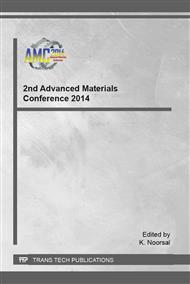[1]
J. Davidovits, Geopolymers, Journal of Thermal Analysis and Calorimetry. 37 (1991) 1633 - 1656.
Google Scholar
[2]
Provis, John L., S. A. Bernal, Geopolymers and related alkali-activated materials, Annual Review of Materials Research. 44 (2014) 299 - 327.
DOI: 10.1146/annurev-matsci-070813-113515
Google Scholar
[3]
M. Criado, A. Fernandez-Jimenez, A. G. de la Torre, M. A. G. Aranda, A. Palomo, An XRD study of the effect of the SiO2/Na2O ratio on the alkali activation of fly ash, Cement and Concrete Research. 37 (2007) 671 - 679.
DOI: 10.1016/j.cemconres.2007.01.013
Google Scholar
[4]
C. A. Rees, J. L. Provis, G. C. Lukey, J. S. J. van Deventer, The mechanism of geopolymer gel formation investigated through seeded nucleation, Colloids and Surfaces A: Physicochemical and Engineering Aspects. 318 (2008) 97 - 105.
DOI: 10.1016/j.colsurfa.2007.12.019
Google Scholar
[5]
C. A. Rees, J. L. Provis, G. C. Lukey, J. S. van Deventer, In situ ATR-FTIR study of the early stages of fly ash geopolymer gel formation, Langmuir: The ACS Journal of Surfaces and Colloids. 23 (2007) 9076 - 9082.
DOI: 10.1021/la701185g
Google Scholar
[6]
A. Hajimohammadi, J. L. Provis, J. S. van Deventer, Time-resolved and spatially-resolved infrared spectroscopic observation of seeded nucleation controlling geopolymer gel formation, Journal of Colloid and Interface Science. 357 (2011) 384 - 392.
DOI: 10.1016/j.jcis.2011.02.045
Google Scholar
[7]
Z. Zhang, H. Wang, J. L. Provis, Quantitative study of the reactivity of fly ash in geopolymerization by FTIR, Journal of Sustainable Cement-Based Materials. 1 (2012) 154 - 166.
DOI: 10.1080/21650373.2012.752620
Google Scholar
[8]
W. K. Lee, J. S. van Deventer, Use of Infrared Spectroscopy to study geopolymerization of heterogeneous amorphous aluminosilicates, Langmuir. 19 (2003) 8726 - 8734.
DOI: 10.1021/la026127e
Google Scholar
[9]
A. Fernandez-Jimenez, A. Palomo, Mid-infrared spectroscopic studies of alkali-activated fly ash structure, Microporous and Mesoporous Materials. 86 (2005) 207 - 214.
DOI: 10.1016/j.micromeso.2005.05.057
Google Scholar
[10]
C. A. Rees, J. L. Provis, G. C. Lukey, J. S. van Deventer, Attenuated total reflectance fourier transform infrared analysis of fly ash geopolymer gel aging, Langmuir: The ACS Journal of Surfaces and Colloids. 23 (2007) 8170 - 8179.
DOI: 10.1021/la700713g
Google Scholar
[11]
A. Autef, E. Prud'Homme, E. Joussein, G. Gasgnier, S. Pronier, S. Rossignol, Evidence of a gel in geopolymer compounds from pure metakaolin, Journal of Sol-Gel Science and Technology. 67 (2013), 534 - 544.
DOI: 10.1007/s10971-013-3111-9
Google Scholar
[12]
M. I. Khan, K. Azizli, S. Sufian, Z. Man, A. S. Khan, Simultaneous preparation of nano silica and iron oxide from palm oil fuel ash and thermokinetics of template removal, RSC Advances. 5 (2015) 20788 - 20799.
DOI: 10.1039/c4ra15922e
Google Scholar
[13]
Lutz, Wolfgang, Attila Ritzmann, Detection of geopolymer structure by spectroscopic and molybdate measurements, Zeitschrift für anorganische und allgemeine Chemie. 639. 10 (2013) 1776 - 1781.
DOI: 10.1002/zaac.201300087
Google Scholar
[14]
C. H. Ruscher, E. Mielcarek, W. Lutz, A. Ritzmann, W. M. Kriven, Weakening of alkali-activated metakaolin during aging investigated by the molybdate method and infrared absorption spectroscopy, Journal of the American Ceramic Society. 93 (2010).
DOI: 10.1111/j.1551-2916.2010.03773.x
Google Scholar
[15]
M. Irfan Khan, K. Azizli, S. Sufian, Z. Man, Sodium silicate-free geopolymers as coating materials: Effects of Na/Al and water/solid ratios on adhesion strength, Ceramics International. 41 (2015) 2794 - 2805.
DOI: 10.1016/j.ceramint.2014.10.099
Google Scholar
[16]
K. A. M. Irfan Khan, Suriati Sufian, Zakaria Man, Effect of Na/Al and Si/Al Ratios on adhesion strength of geopolymers as coating material, Applied Mechanics and Materials. 625 (2014) 85 - 89.
DOI: 10.4028/www.scientific.net/amm.625.85
Google Scholar
[17]
I. Ismail, S. A. Bernal, J. L. Provis, R. S. Nicolas, S. Hamdan, J. S. J. van Deventer, Modification of phase evolution in alkali-activated blast furnace slag by the incorporation of fly ash, Cement & Concrete Composites. 45 (2014) 125 - 135.
DOI: 10.1016/j.cemconcomp.2013.09.006
Google Scholar
[18]
Z. Zhang, H. Wang, J. L. Provis, F. Bullen, A. Reid, Y. Zhu, Quantitative kinetic and structural analysis of geopolymers. Part 1. The activation of metakaolin with sodium hydroxide, Thermochimica Acta. 539 (2012) 23 - 33.
DOI: 10.1016/j.tca.2012.03.021
Google Scholar
[19]
Z. Zhang, J. L. Provis, H. Wang, F. Bullen, A. Reid, Quantitative kinetic and structural analysis of geopolymers. Part 2. Thermodynamics of sodium silicate activation of metakaolin, Thermochimica Acta. 565 (2013) 163 - 171.
DOI: 10.1016/j.tca.2013.01.040
Google Scholar


